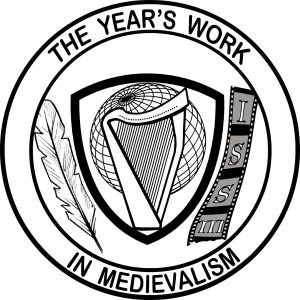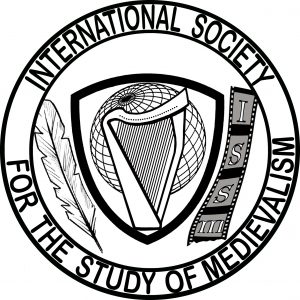Karl Fugelso
Towson University
Just before the end of the comic-book story “Messer Papero e il Ghibellin Fuggiasco,” Uncle Scrooge and Donald Duck pretend to be Guelphs in a spectacularly failed attempt to win over a posse chasing their friend Dante Alighieri, as, not realizing that the poet’s flattering letter to the Holy Roman Emperor could come from a White Guelph, Scrooge mistakenly assumes that Dante must be a Ghibelline and that all the fugitive’s political enemies must be Guelphs (Fig. 1).1
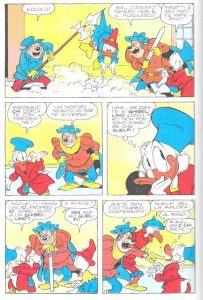
Figure 1: Scrooge Lies to the Posse.
The considerable historical and literary knowledge necessary to comprehend this episode may not have been too much for Italian audiences, but the same does not seem to have been true for American audiences, or at least not those anticipated by the publisher, for unlike some other stories featuring Scrooge and/or Donald, this 1983 tale from Disney’s Italian serial Topolino has never been translated into English and reprinted in the United States.2 Even as this most Italian of narratives from the most American of companies demonstrates the range and flexibility of medievalism, it also foregrounds cultural relativism in how history and literature, especially that of the Middle Ages, have been perceived, repackaged, and consumed in the West, particularly via the entertainment industry and most particularly in the ways it caters to children.3 As can be seen by comparing this story’s plot, textual framing, and reception to those for other Disney tales from Italy and/or the US, medievalism can reflect and contribute to regional and national identities even while, and indeed perhaps by, otherwise transcending their borders.
In overtly referencing classic literature and history, this narrative, which was illustrated by Giovan Battista Carpi and written by him and Guido Martina, is far from unique even within its own serial.4 In fact, it is just the first of seven such tales Scrooge tells across seven consecutive volumes of Topolino, as he and Donald encounter the treacherous and perhaps cannibalistic Count Ugolino from canto 33 of the Inferno, the no-less-treacherous counterfeiter Master Adam from canto 30 of the Inferno, Giotto, who famously appears in canto 11 of Purgatorio, the pirates of Montecristo, the eighteenth-century la Grotta di Eolo at Caserta, Lorenzo the Magnificent, and the discovery of the “New World.” Moreover, it is preceded in this serial by dozens of other stories that feature Scrooge and/or Donald traveling back in time directly or via literary classics, as when Donald appears as Don Quixote,5 he and Scrooge embody “Parpagnan” and “Trentaville” in The Three Musketeers,6 and are “Paperin Caramba” and “Don Pepo Paperon” in Carmen.7
Yet, while these precedents may mean that many audience members bring a degree of familiarity with and expectations for the sort of narrative designs behind the ducks’ Ghibelline-Guelph fiasco, that degree depends on not only how many such forerunners the audience has encountered but also whether the precedents are by Italians. Especially as that nation’s publishers tried to recover from World War II, many of the feature stories in Topolino and Disney’s other Italian franchises were translated from comic books originating in other countries, particularly the United States.8 Some of these American imports, especially those by Carl Barks, are so narratively clear, expressive, and inventive that they have been reprinted several times in Topolino alone, not to mention other Italian publications.9 But none of these stories have been reissued in Italy nearly as often as the most popular duck-tales by Italians, perhaps in part because even the stories by Barks, who may be the most history-oriented of the ducks’ American producers, usually present the past as little more than a pretext for an otherwise standard treasure hunt.10
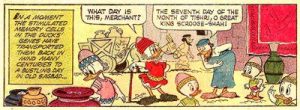
Figure 2: The Ducks Are Transported to Ancient Persia in “King Scrooge the First.”
In “King Scrooge the First,” for example, Barks drops Donald and his uncle into Ancient Persia via a mysterious potion from a fortune teller who wants them to reveal where their ancestors hid their wealth (Fig. 2);11 in “Back to Long Ago,” Barks has a hypnotist convince Donald and Scrooge that they are sixteenth-century privateers who buried loot for their twentieth-century selves to find;12 and in “Old California,” Barks transports Donald and his nephews via simultaneous head injuries to the 1848 Gold Rush.13
Disney’s Italian artists and authors, on the other hand, rarely settle for deploying history, whether directly or via literary classics, as a mere backdrop for one of the company’s standard narratives. Indeed, as with “Ghibellin Fuggiasco,” the Italians tend to reverse the relationship between the past and such plots by bringing the anticipatory (yet safe) excitement that comes from familiarity with a narrative arc to episodes that are important in history and/or literature but so geographically, chronologically, and/or culturally distant that, in and of themselves, they are not likely to engage the audience. That is, rather than turn to history and literature to energize conventional Disney plots, the Italians exploit the pattern of those narratives to enliven history and literature that might otherwise be boring, didactic, and thoroughly forgettable.
In true Disney fashion, for example, “Ghibellin Fuggiasco” builds gradually towards the explosive confrontation with the posse, then quickly wraps it up with a comparatively happy ending that doubles as a segue into Scrooge’s next story. After a long introduction during which Donald and his uncle arrive by jet in Florence and learn of Dante, Scrooge is inspired by the poet to tell of a rich wool merchant in early fourteenth-century Florence who looks suspiciously like Scrooge himself (Fig. 3)14 and began his fortune with two gold florins he conned from Dante in exchange for leading the poet out of a “SELVA OSCURA.”15
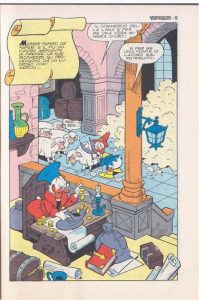
Figure 3: Scrooge and Donald as a Trecento Wool Merchant and his Assistant.
After describing this encounter to his assistant, who looks remarkably like Donald, the merchant notes that Dante headed off for hell, returned to Florence three days later, and now, two years later, is immersed in politics. At that very moment the ducks hear a lynch mob storming through the streets searching for an unnamed traitor, and that night the fugitive, Dante, shows up at the ducks’ door seeking refuge (Fig. 4).16
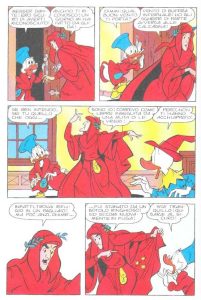
Figure 4: Dante Arrives at the Ducks’ Home.
Suspecting that this haven is only temporary, the poet then convinces the merchant to stampede his flock of sheep out of town and let Dante hide like Ulysses among them, which occurs moments before the sheriff and his posse break down the merchant’s door, futilely search for the poet, accuse the ducks of hiding Dante, arrest them as Guelphs, and haul them off to court. There, a Ghibelline judge sets them on the path to exile with nothing more than the clothes on their back, a donkey, and, unbeknownst to the judge, a barrel of money disguised as wine (Fig. 5).17
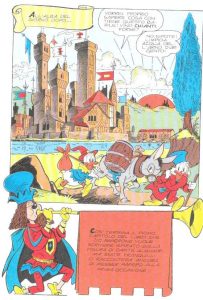
Figure 5: The Ducks Go into Exile.
A slow build-up reaches a seemingly disastrous crescendo that ends comparatively well and sets up the heroes for subsequent adventures.
This is not to say, however, that Disney’s Italian artists and authors rely solely on such narrative conventions to engage their audience in the literary and historical details around which they build their stories, for usually they also provide at least some degree of broader context. Indeed, Carpi and Martina embed the ducks’ encounter with the posse in nested narratives that each provide some background on Dante’s life, his major writings, and/or the politics behind his exile, not to mention the way in which he inspired Scrooge and Donald to imagine themselves living in the early fourteenth century. Upon arriving in Florence, the ducks are given an impromptu tour by a local boy, who, noting that the city’s tremendous wealth sprang from the wool trade, points out the Palazzo Vecchio, the cathedral and its campanile, the Palazzo del Bargello, and Santa Croce (Fig. 6).18
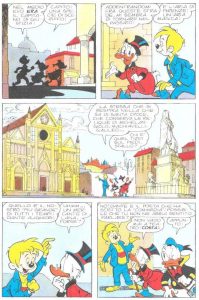
Figure 6: Scrooge Asks His Guide about a Statue.
After Scrooge subsequently asks the identity of the Dante statue in front of the latter, the guide takes the opportunity to explain that the subject is the poet who wrote the Divine Comedy, and the boy scolds Scrooge for not knowing that this is the poem that begins with the famous lines “NEL MEZZO DEL CAMMIN DI NOSTRA VITA, MI RITROVAI PER UNA SELVA OSCURA” and that tells of Dante’s voyage to the “ALTRO MONDO,” where he met “PERSONAGGI FAMOSI, BUONI E CATTIVI.”
Fortunately, Scrooge is not so much chastised as inspired by this brief description and immediately launches into the series of tales that begin with his 1302 merchant telling his assistant about having met Dante two years earlier in the dark forest, well before the poet’s recent letter to the Holy Roman Emperor—to a figure whom the merchant characterizes only as the hero of all Ghibellines and, implicitly, the enemy of all Guelphs. That is, rather than detail the motives behind these party divisions, much less the splits within each party that led to such factions as the Black Guelphs and the White Guelphs, Carpi and Martina have their surrogate narrator go into just enough description to indicate the extraordinary complexity of a historical conflict that would not, on the surface at least, seem likely to stir the interest of anyone who did not already have some knowledge of it.
At least by 2016, however, this strategy may have been inadequate, for when “Ghibellin Fuggiasco” was reprinted that year, the publisher closed the volume with five short essays on Dante’s life as a whole, his physical appearance, his love for Beatrice, his politics, and the conflict between the “Guelfi e Ghibellini, Bianchi e Neri.”19 Yet even these supplements assume far more knowledge than do most literary and/or historical explanations in Disney’s American comic books. On the inside of the back cover for the 2006 American edition of “L’Inferno di Topolino,” for instance, Dwight R. Decker begins his “Translator’s Notes” by saying:
It may have been the strangest spring break on record. Over Easter weekend in the year 1300, it is said, the ghost of the Roman poet Virgil led an Italian poet named Dante Alighieri on a guided tour of the Inferno – the place where sinners are punished after they die. Dante’s epic poem recounting his journey appeared some years later, and a masterpiece was added to Italian literature.20
And while explaining why that story was retranslated for its 2016 reissue, the Editor-in-Chief, Jim Salicrup, notes:
The epic poem Divine Comedy by Durante degli Alighieri, better known as Dante (c. 1265-1321), [. . .] is considered by many to be the greatest literary work ever composed in the Italian language, and a masterpiece of world literature. The poem describes Dante’s journey through Hell (Inferno), Purgatory (Purgatorio), and Paradise (Paradiso), guided by the Roman poet Virgil, and then by his true-love Beatrice.21
Of course, not all Disney stories by Italian artists and authors are quite as oriented around history and literature as is “Ghibellin Fuggiasco,” or assume as much knowledge about it. Like Disney’s American stories, some have content that is geared towards the same pre-literate or barely literate audiences that are accommodated by the means through which the narrative is articulated: by the text’s short, basic, often slangy words and brief, uncomplicated sentences and by the illustrations’ extraordinarily expressive poses, exaggerated facial features, dynamic and consistent but simple perspective, bold outlines, and complementary pairing of bright, monochromatic blocks of color. Indeed, judging from the number of subsequent editions, not only have several of Disney’s American stories achieved a modicum of success in Italy, but some of the company’s Italian stories have been sufficiently free of literary and historical references to do quite well in the US.
Yet, even as “Ghibellin Fuggiasco” joins many of its Italian and American counterparts in demonstrating the tremendous range and flexibility of reactions to the past in general and to the Middle Ages in particular, this story and many of Disney’s other Italian tales foreground the cultural relativism through which medievalism and other such responses are often refracted. Though it is true that some of the American duck-stories have been imported to Italy and even enjoyed a bit of success there, they are, as I noted earlier, more oriented around literature and history than are most of the other stories produced in the States. And the Italian stories exported to America are comparatively few and, relative to Disney’s other Italian narratives, only superficially refer to history and literature, if indeed they do so at all.22 Far more of the Italian narratives are at least as oriented as “Ghibellin Fuggiasco” around literary and historical episodes that many non-Italians, perhaps particularly Americans, have never heard of or would consider very minor, as with the aforementioned tales about Master Adam and the pirates of Montecristo; many of those stories presume at least as much knowledge as “Ghibellin Fuggiasco.”
Such cultural relativism with regard to the basic content of these responses to the past may not be surprising, for every country has its own history and literature, and most tend to privilege their own over those of other nations. Yet, while a cultural cornerstone like Dante may be no more surprising to find in an Italian comic book than, say, Benjamin Franklin or Mark Twain in the many American comic books that reference them,23 one would be challenged to find an American comic book, particularly by Disney and other publishers catering to very young audiences, that revolves around such an important but obscure topic as the Guelph-Ghibelline conflict, around, say, the Federalist debate. And even if one were to discover such a comic book, it almost certainly would not presume as much literary and historical knowledge as does “Ghibellin Fuggiasco,” especially without the explanations appended to the latter’s reprints in 2016 and 2020.
This national difference in the amount as well as detail and sophistication of assumed knowledge, not to mention interest, may stem from the possibility that Disney’s Italian comic books presuppose an older audience than do their American comic books, or at least that their Italian comic books did so in 1983, 2016, and 2020. But this hypothesis is undermined by the fact that, during those years, there is not an appreciable price difference between an American Disney comic book and an Italian Disney comic book, which suggests that none of these books favored adults and older children over younger, and presumably poorer, children.24 Moreover, as we have seen, the text and images in these Disney comic books suggest that the company attempted to make all of them accessible to and engaging for young audiences. And surveys of fan blogs and websites do not reveal any discernible national difference in the age of Disney’s comic-book buyers.25
Of course, differences from one country to the other in assumptions about the knowledge and interest of these comic books’ audiences may revolve around different cultural exposure and approaches to such knowledge. With regard to the Middle Ages, as with antiquity and virtually all other eras, Italians are often surrounded by far more physical reminders of their past than are American children of any but the most recent periods of their own history. And, as with many other European regions, Italian early education is often seen as more focused on history and literature, particularly their own, than are American elementary and middle schools.26 But while some Italian children certainly are surrounded by more numerous reminders of pre-modern history than are American children, and while some Italian children may receive much more education in history and literature (particularly those of Italy) than do American children, such generalizations are difficult to confirm, clearly wrong in many instances, and perhaps never very helpful.
Far more likely is that, regardless of the origin for these differences, they are reinforced by these comic books. In building on different assumptions and catering to different kinds of audiences, “Ghibellin Fuggiasco” and other Italian stories that revolve around Italian history and Italian literature perpetuate those differences. As with Disney’s American comic books, and perhaps those in all other countries, they feed cycles of knowledge and assumption within each nation that reinforce differences from one country to another. Even as they demonstrate the tremendous flexibility of responses to history by blurring the differences between, in this case, the Middle Ages and medievalism, the past and the present, fact and fiction, didacticism and parody, and, concomitantly, medievalism and neomedievalism,27 they foreground the cultural constraints on that adaptability. They point to limits in the degree to which not only they but perhaps all forms of (neo)medievalism can transcend milieux.
- Giovan Battista Carpi and Guido Martina, “Messer Papero e il Ghibellin Fuggiasco,” Topolino 1425 (Milan: Mondadori [for Disney Enterprises], March 20, 1983), 1-29. I use the traditional label “comic book” rather than “graphic novel” to discuss these works featuring talking ducks and other animals that the Disney corporation has long geared towards children.
- For an accounting of all Disney reprints, see the International Network of Disney Universe Comic Knowers and Sources (I.N.D.U.C.K.S.) at http://coa.inducks.org/.
- For an introduction to the ways in which the Disney Company’s business strategies play on cultural relativism, especially in attempting to manipulate its anticipated and actual audiences and especially with regard to medievalism, begin with The Disney Middle Ages: A Fairy-Tale and Fantasy Past, ed. Tison Pugh and Susan Aronstein (New York: Palgrave Macmillan, 2012). For more on these issues with regard to Italian medievalism in particular, begin with Matteo Sanfilippo’s Il Medioevo Secondo Walt Disney: Come l’America Ha Reinventato l’Età di Mezzo (Rome: Castelvecchi, 1993), especially “Il Medioevo Secondo Walt Disney,” 83-100.
- For more on Carpi and Martina, see the creator pages at I.N.D.U.C.K.S. and respective Wikipedia entries (accessed November 5, 2021, https://en.wikipedia.org/wiki/Giovan_Battista_Carpi and https://it.wikipedia.org/wiki/Guido_Martina).
- Guido Martina and Pier Lorenzo de Vita, “Paperino Don Chisciotte,” Topolino 137-9 (Milan: Mondadori [for the Walt Disney Company], April 25, May 2, and May 10, 1956).
- Guido Martina and Pier Lorenzo De Vita, “Paperino e i tre moschettieri,” Topolino 162-3 (Milan: Mondadori [for the Walt Disney Company], May 10 and May 25, 1957).
- Guido Martina and Giovan Battista Carpi, “Paperin Caramba y Carmen Olé,” Topolino 1253 (Milan: Mondadori [for Disney Enterprises], December 2, 1979).
- For the pithiest and most up-to-date history of Disney comics in Italy, specifically Topolino, see https://en.wikipedia.org/wiki/Topolino.
- See I.N.D.U.C.K.S. for details of when and where Disney stories have been reprinted.
- For a brief and efficient discussion of Barks and his interest in and use of history, see his Wikipedia entry, https://en.wikipedia.org/wiki/Carl_Barks; a much more extensive discussion is available at https://www.cbarks.dk.
- Carl Barks (author) and Tony Strobi (illustrator), “King Scrooge the First,” Uncle Scrooge 71 (Poughkeepsie: Gold Key [licensing from the Walt Disney Company], October 1, 1967).
- Carl Barks, “Back to Long Ago,” Uncle Scrooge 16 (New York: Dell Publishing [licensing from the Walt Disney Company], December 1, 1956).
- Carl Barks, “Old California,” Four Color 328 (New York: Dell Publishing [licensing from the Walt Disney Company], May 1, 1951).
- Carpi and Martina, “Messer Papero e il Ghibellin Fuggiasco,” Topolino 1425.
- I follow the lead of the story’s letterer in using only capital letters for quotations.
- Carpi and Martina, “Messer Papero e il Ghibellin Fuggiasco,” Topolino 1425.
- Carpi and Martina, “Messer Papero e il Ghibellin Fuggiasco,” Topolino 1425.
- Carpi and Martina, “Messer Papero e il Ghibellin Fuggiasco,” Topolino 1425.
- “L’Inferno di Topolino” e Altre Storie Ospirate a Dante Alighieri, ed. Susanna Carbonari, Capolavori della Letteratura (Florence and Milan: Giunti Editore [for Disney Enterprises], 2016).
- Dwight R. Decker, “Translator’s Notes,” Walt Disney’s Comics and Stories 666, ed. Leonard (John) Clarke (Timonium: Gemstone Publishing [for Disney Enterprises], March 2006).
- Jim Salicrup, “Watch out for Papercutz,” Great Parodies: “Mickey’s Inferno”, Disney Graphic Novels 4, ed. Jim Salicrup (New York: Papercutz [Macmillan] [for Disney Enterprises], December 2016), 78.
- National origins of Disney’s American comic books, and often particular creators, are available at I.N.D.U.C.K.S.
- For an American comic-book appearance by Franklin, see Bill Finger and Al Plastino, “Benjamin Franklin’s Super Reporter,” Adventure Comics Vol 1 296 (New York: DC Comics, May 1962), and for Twain, see Frederick B. Guardineer’s biography in It Really Happened 10 (New York: Pines Publishing, August 1947).
- In 1983, when an American Disney comic book cost an average of 60 cents and an Italian Disney comic book cost an average of 800 lire, the exchange rate averaged 1518.85 lire per dollar, according to Pacific Exchange Rate Service (https://fx.sauder.ubc.ca/etc/USDpages.pdf, accessed November 5, 2021). In 2016, when an American Disney comic book cost an average of $3.99 and an Italian Disney comic book cost an average of 3€, the average exchange rate according to that same service and adjusted for Italy’s adoption of the Euro in 2002 was 1750.46 lire, at a time when, according to Exchange Rates UK, the Euro was worth an average of $1.1068 (https://www.exchangerates.org.uk/EUR-USD-spot-exchange-rates-history-2016.html, accessed November 5, 2021). In 2020, when an American Disney comic book still cost an average of $3.99 and an Italian Disney comic book still cost an average of 3€, the Euro was worth an average of $1.142, according to Exchange Rates UK.
- Perhaps the most prominent and visited of these many blogs and websites are Disney Comics Randomness (http://disneycomicsrandomness.blogspot.com), and I.N.D.U.C.K.S. For more on the aging of the comic-book buying population in Italy and elsewhere, begin with Heidi MacDonald’s condescending but informative article, “Report Says 25% of Comic Readers Are over 65,” The Beat, accessed November 5, 2021, http://www.comicsbeat.com/report-says-25-of-comics-readers-are-over-65/.
- 2626 The focus of Italian elementary and middle schools has been officially shifting since 1985 towards not only an ever-greater focus on math and science but also a more multi-cultural perspective in the humanities and social sciences (The StateUniversity.com Education Encyclopedia, accessed November 5, 2021, https://education.stateuniversity.com/pages/716/Italy-EDUCATIONAL-SYSTEM-OVERVIEW.html), though the apparent need for the frequent government decrees promoting these shifts suggests that Italian history and Italian literature still have pride of place, as it were, in many Italian students’ early curriculum.
- For some of the most prominent of the many definitions that claim neomedievalism’s satirical approach distinguishes it from other forms of medievalism, see Pamela Clements and Carol L. Robinson, “Living with Neomedievalism,” Studies in Medievalism XVIII: Defining Medievalism(s) II, ed. Karl Fugelso (Cambridge: D. S. Brewer, 2009), 55-75; Clements and Robinson, “Neomedievalism Unplugged,” Studies in Medievalism XXI: Corporate Medievalism, ed. Karl Fugelso (Cambridge: D. S. Brewer, 2012), 191-206; Lesley Coote, “A Short Essay about Neomedievalism,” Studies in Medievalism XIX: Defining Neomedievalism(s), ed. Karl Fugelso (Cambridge: D. S. Brewer, 2010), 25-33; Lauryn S. Mayer, “Dark Matters and Slippery Words: Grappling with Neomedievalism(s),” Studies in Medievalism XIX: Defining Neomedievalism(s), ed. Karl Fugelso (Cambridge: D. S. Brewer, 2010), 68-76; and Brent Moberly and Kevin Moberly, “Neomedievalism, Hyperrealism, and Simulation,” Studies in Medievalism XIX: Defining Neomedievalism(s), ed. Karl Fugelso (Cambridge: D. S. Brewer, 2010), 12-24.

